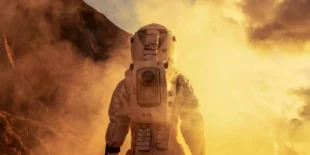A recent study published in Astrobiology suggests that four types of bacteria known to cause illness in humans on Earth may have the potential to survive and thrive under the harsh conditions of Mars if carried by astronauts.
Scientists conducted an experiment where colonies of Burkholderia cepacia, Klebsiella pneumoniae, Pseudomonas aeruginosa, and Serratia marcescens were placed in a box designed to mimic the Mars-like environment, characterized by a lack of water, low atmospheric pressure, intense ultraviolet radiation, and toxic salts. These bacteria are typically harmless on Earth but can become pathogenic when stressed.
Initially, scientists expected that the regolith or soil resembling the Martian surface would have a toxic effect on the bacteria, limiting their growth. However, they were surprised to find that three of the species survived, with Pseudomonas aeruginosa showing steady growth for up to three weeks.
Microbiologist Tommaso Zaccaria and his colleagues are now working to understand how these microbes managed to survive. Zaccaria suggests that the bacteria may have found small pockets of water within the regolith, providing nutrients and protection from deadly UV radiation.
The study’s results have implications for future human missions to Mars. Scientists recommend that these missions carry a variety of antibiotics to address disease-causing bacteria that may survive and potentially mutate on Mars, posing a health risk to astronauts. Additionally, precautions must be taken to avoid mistaking terrestrial bacteria for native Martian life during research.
Zaccaria also suggests that certain areas of Mars should be designated as protected zones, similar to national parks, where only robotic vehicles are allowed to enter. This would help preserve the Martian environment and prevent contamination.
The search for life beyond Earth is a fundamental part of exploring our solar system, with Mars being a prominent candidate for potential colonization. Currently, the Perseverance rover is actively exploring the Martian surface as part of international efforts to uncover the secrets of the Red Planet.


